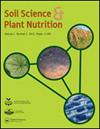糙米中的砷和镉浓度可以通过了解抽穗前后每周供水量的影响来控制
IF 1.8
4区 农林科学
Q3 ENVIRONMENTAL SCIENCES
引用次数: 0
摘要
砷(As)和镉(Cd)对人体有害,其在水稻中的浓度受稻田水管理策略的影响。然而,水管理被认为是农民的负担,因此需要一种有效的策略来降低糙米中砷和镉的浓度。本研究的目的是以周为单位,评估水分管理对糙米抽穗前后3周内砷和镉总浓度的影响。此外,本研究旨在确定土壤类型和品种之间这种效应的差异。在L12正交试验台上进行了水稻盆栽试验,研究了每周2个水平的水淹和排水对糙米中砷和镉浓度的影响。土壤氧化还原电位在淹水过程中下降,在排水过程中上升,但安土土壤在淹水过程中下降的速度比河流土壤慢。对生长在Fluvisols中的植物,糙米中总砷和总镉浓度分别随淹水而升高和降低,随排水而相反。在粳稻品种“光”和“Hitomebore”中,抽穗后第1周(0 ~ 2天)的水分管理对砷和镉浓度的影响最大。然而,在籼稻品种“高稻”中,对砷和镉浓度影响最大的周分别是抽穗后第2周和第1周。在安土中,镉浓度随水分管理的变化而变化,与河流中一样,但在as中没有发现相同的变化。这表明水分管理对糙米中砷浓度的影响可以被安多酚吸收砷的能力所抵消。然而,也有可能由于安多酚的低砷浓度而无法检测到水管理的影响。这些结果将有助于利用水稻品种和土壤类型的信息有效地降低砷和镉浓度。本文章由计算机程序翻译,如有差异,请以英文原文为准。
Arsenic and cadmium concentrations in brown rice can be controlled by understanding the impacts of weekly water contributions before and after heading
ABSTRACT Arsenic (As) and cadmium (Cd) are harmful to humans, and their concentrations in rice are affected by the water management strategies used in paddy fields. Water management, however, is considered a burden for farmers, and thus an efficient strategy by which to decrease As and Cd concentrations in brown rice is desired. The purpose of this study was to estimate the effects of water management on the total As and Cd concentrations in brown rice during the 3 weeks before and after heading on a weekly basis. Moreover, the study aimed to determine the differences in this effect among soil types and cultivars. Pot cultivation experiments of rice were conducted by applying two levels of weekly flooding or draining to an L12 orthogonal table, and their effects each week on the As and Cd concentrations in brown rice were identified. Redox potentials of soils decreased during flooding and increased during draining, but the decrease during flooding in Andosols was slower than that in Fluvisols. For the plants growing in Fluvisols, the total As and Cd concentrations in the brown rice increased and decreased with flooding, respectively, and an opposite trend was observed with draining. In the Japonica varieties ‘Koshihikari’ and ‘Hitomebore,’ water management during the first week from 0 to 2 days after heading had the greatest impact on As and Cd concentrations. However, in the Indica variety ‘Takanari,’ the weeks that most affected the As and Cd concentrations were the second and first week from the day after heading, respectively. In the Andosols, the Cd concentration was changed by water management as in the Fluvisols, but the same was not found for the As. This suggests that the effect of water management on the As concentration in brown rice could be nullified by the Andosols ability to absorb As. However, it was also possible that the effect of water management could not be detected due to the low As concentration of the Andosols. These results provide insights that will help to efficiently reduce As and Cd concentrations using information on the rice variety and soil type.
求助全文
通过发布文献求助,成功后即可免费获取论文全文。
去求助
来源期刊

Soil Science and Plant Nutrition
农林科学-农艺学
CiteScore
4.80
自引率
15.00%
发文量
56
审稿时长
18-36 weeks
期刊介绍:
Soil Science and Plant Nutrition is the official English journal of the Japanese Society of Soil Science and Plant Nutrition (JSSSPN), and publishes original research and reviews in soil physics, chemistry and mineralogy; soil biology; plant nutrition; soil genesis, classification and survey; soil fertility; fertilizers and soil amendments; environment; socio cultural soil science. The Journal publishes full length papers, short papers, and reviews.
 求助内容:
求助内容: 应助结果提醒方式:
应助结果提醒方式:


